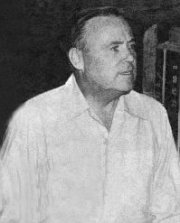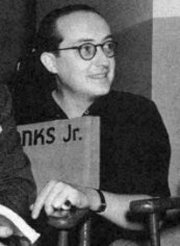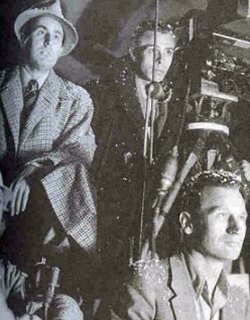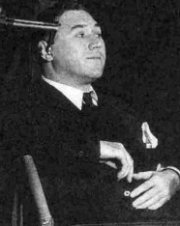

Page 2 of 3
My primary objective in making a film was always to provide entertainment. In my opinion, the only accurate barometer we had for judging the entertainment value of a picture was audience reaction...
At no time had I any interest in making a film for the purpose of imposing my views, political or social, on an audience that had paid to be entertained....
director, Clarence Brown
[Directing: Learn from the Masters, pp. 13]

Edward H. Griffith
Born - August 23, 1894,
Lynchburg, Virginia
Died -
March 3, 1975,
South Laguna, California
Films with Tyrone Power
Ladies in Love (1936)
Cafe Metropole (1937)
Griffith's directing career spanned thirty years, from 1917 through 1946, during which he
directed about sixty films. In 1915 he began work for Edison Company, which produced silent films until about 1920, as a scenario
writer. He was supplementing his work as a writer with acting jobs. Then, within two
years, he became a director for the company. In this early phase of his career, he was mixing writing and directing careers. He continued his directing career through the 1920's by directing for various studios. In the 1930's he was working for major studios, directing many of that era's most notable female stars, including Madeline Carroll, Constance Bennett, Loretta Young, Margaret Sullavan, and Joan Crawford. He directed many of the female stars multiple times, for they "demanded his services to showcase their talents. Generally, the vehicles he created for them were quite successful, enhancing their images." [The Illustrated Guide to Film Directors, p. 122] Among Griffith's films are 1935's No More Ladies, 1936's Next Time We Love, 1939's Honeymoon in Bali, 1940's Safari, and 1943's The Sky's the Limit. His last movie was the 1946 film, Perilous Holiday.

Henry Hathaway
Born - March 13, 1898,
Sacramento, California
Died - February 11, 1985,
Hollywood, California (heart attack)
Films with Tyrone Power
Brigham Young - Frontiersman (1940)
Johnny Apollo (1940)
The Black Rose (1950)
Rawhide (1951)
Diplomatic Courier (1952)
Henry Hathaway's film career as a director spanned about fifty years, which included five or six years in the early days, as an assistant director. He began work as a child actor in 1932, but his acting career was cut short by World War I. When he returned from the war, he became an assistant director, mostly for Paramount. Gradually, he moved through the ranks at Paramount - from directing two-reel westerns to directing full-length "B" movies by 1932. During the years 1932-1933, he directed Randolph Scott in a half dozen Zane Grey westerns. By 1934, he was moving away from the Zane Grey films. That year he directed Richard Arlen and Ida Lupino in Come on Marines. Before he left Paramount, he had made such feature films as The Witching Hour, Now and Forever, The Trail of the Lonesome Pine, Go, West Young Man, and The Lives of a Bengal Lancer. 1938's Spawn of the North marked the end of his long association with Paramount. For a brief period, 1939-1941, Hathaway freelanced as a director. During
this time, he directed 1939's The Real Glory for Samuel Goldwyn Company. In 1940,
he directed two pictures for 20th Century-Fox - Brigham Young - Frontiersman and
Johnny Apollo. In 1941 he directed Sundown for Walter Wanger Productions Inc.
and The Shepherd of the Hills for Paramount Pictures. Hathaway then signed a contract with 20th Century-Fox. In his long association with Fox, he would direct about twenty-five films, beginning with Ten Gentlemen from West Point in 1942.
Among the films he did during this period were 1944's Wing and a Prayer, 1946's Rue Madeleine (which starred James Cagney and Annabella), 1947's Kiss of Death, 1948's Call Northside 777, 1953's Niagara, and 1956's 23 Paces to Baker Street . With the 1960 movie North to Alaska, starring John Wayne, he would ended his lengthy tenure at 20th Century-Fox. During the 1960's Hathaway freelanced as a director and continued to make such popular films as How the West Was Won, Nevada Smith, The Sons of Katie Elder, and True Grit. By the 1970's, Hathaway's career had tapered off, and he retired in 1974. Hathaway had a reputation for
being a tough, but very professional director. Many of his movies were considered to rank with the better works of the great directors, Howard Hawks and John Ford. Many actors found Hathaway difficult to work with, as he was very demanding and blunt. Hathaway and his wife were personal friends of Tyrone Power.

Henry King
Born - January 24, 1886,
Christiansburg, Virginia
Died - June 29, 1982,
Toluca Lake, California (heart attack)
Films with Tyrone Power
Lloyd's of London (1936)
In Old Chicago (1937)
Alexander's Ragtime Band (1938)
Jesse James (1939)
A Yank in the R.A.F. (1941)
The Black Swan (1942)
Captain from Castile (1947)
Prince of Foxes (1949)
King of the Khyber Rifles (1953)
Untamed (1955)
The Sun Also Rises (1957)
Henry King was the actor who helped Tyrone Power get his big break in Hollywood. When
Ty's career was going nowhere, he came to King to ask for a role in one of his upcoming
movies. King helped him get the starring role in Lloyd's of London, which launched
not only Ty's film career but also a great friendship between him and King. Tyrone Power
became King's favorite actor and the one with whom he made the most sound films. (The only other actor who acted in as many movies for King was William Russell, who starred in eleven silent movies.)
Henry King once said, "I've had more fun directing pictures than most people have playing games." (New York Times, June 30, 1978). He certainly had a long, productive career as a director. As a young man, he performed on stage, vaudeville, and road shows. He made his first
film appearance in 1912, and three years later began directing. He had given up acting by 1920 to devote his time to directing. His first big success came with 1921's Tol'able David. In 1930 King joined Fox Film Corporation and made his first movie for that company, Lightnin', which starred their biggest star, Will Rogers. When Fox Film Corporation merged with 20th Century Pictures in 1935, King stayed on. He remained with
20th Century-Fox for the rest of his career, filming his last movie,
Tender Is the Night, in 1962. Throughout his career, he was responsible for many successful films. Among his films are 1945's A Bell for Adano, 1949's Twelve O'Clock High, 1950's The Gunfighter, 1952's The Snows of Kilimanjaro, 1955's Love Is a Many-Splendored Thing, 1956's
Carousel, and 1958's The Bravados . He was nominated for an Oscar for Best Director
in 1944 for The Song of Bernadette and in 1945 for Wilson. The fact that he never was awarded an Oscar has been criticized as "one of Hollywood's deeper miscalculations". [The Illustrated Guide Film Directors, p. 165].
Though King has not received a great deal of recognition for his work, he has been praised for his "craftsmanship, durability, and track record at turning out commercial successes." Frank Capra called him "the most under publicized filmmaker in Hollywood." It has been
said that "King has probably given as much pleasure to people in cinema as any other American director." [The Illustrated Guide Film Directors, p. 165].

Henry Koster
Born - May 1, 1905,
Berlin, Germany
Died - September 21, 1988, Camarillo, California
Films with Tyrone Power
The Luck of the Irish (1948)
Koster became a screenwriter in the German film industry in 1925 and, by 1932, was directing. His son, Bob Koster, wrote a brief bio for the IMDB for his father. Koster explained how his dad came to leave Germany in 1933: "Dad was in the midst of directing a film, had already been subject of anti-Semitism, knew he had to leave. Lost temper at SS officer at his bank during lunch hour, knocked the officer out. Had to go directly to railroad station and leave country." Koster fled Germany to escape the Nazis and moved to France, where he continued to work in cinema. He eventually made his way to Budapest, where he continued his work. He met Universal's producer Joe Pasternak in Europe, and directed two films for him in 1934 and one in 1936: Peter, Kleine Mutti, and die Letzte Katharina . Universal then brought him to the United States, where he worked closely with the young actress, Deanna Durbin, showing her to excellent advantage in the six musicals he made with her. Koster continued directing a number of musicals and comedies during the late 1930's and early 1940's. In 1943, he moved to MGM, where he stayed until 1947; then, he moved to 20th Century-Fox. Among the films that he made for 20th Century-Fox were 1949's Come to the Stable, 1950's Wabash Avenue, 1952's My Cousin Rachel, 1953's The Robe, 1954's Desirée, 1955's Good Morning, Miss Dove, 1956's D-Day the Sixth of June, and 1962's Mr. Hobbs Takes a Vacation . Among films that he made for other studios are The Power and the Prize (1956, for MGM), My Man Godfrey (1957, for Universal); Flower Drum Song (1961, for Universal); and The Singing Nun (1966, for MGM);

Sidney Lanfield
Born - April 20, 1898,
Chicago, Illinois
Died - June 20, 1972,
Marina del Rey, California (heart attack)
Films with Tyrone Power
Second Fiddle (1939)
Thin Ice (1937)
Lanfield, schooled in slapstick comedy, became a gag writer for Fox Film Corporation in the mid 1920's. Before too long, he was writing screen stories and screenplays. In 1930, he was directing and had directed over a dozen films by 1935, but none especially notable.
In 1936, Lanfield made quite a gaffe when he asked Darryl F. Zanuck to replace Ty in the cast for Sing, Baby, Sing, reportedly telling Ty that he should find another line of work, as he would never become a movie star.
Lanfield's career really took off later in 1936 when he directed One In a Million, featuring Olympic gold skating champion, Sonja Henie. Two of his greatest successes after that also starred Sonja Henie: Thin Ice , in 1937, and Second Fiddle, in 1939. The leading man in those two movies was the guy
he had told he would never become a movie star. Following Second Fiddle, Lanfield directed 1939's Swanee River and then left Fox to freelance. His next picture was You'll Never Get Rich in 1941 for Columbia. At Paramount, he was paired with Bob Hope, for a number of movies: 1942's My Favorite Blonde, 1943's Let's Face It, 1947's Where There's Life, 1949's Sorrowful Jones, and 1952's The Lemon Drop Kid. He made another picture at Samuel Goldwyn Company with Bob Hope, 1944's The Princess and the Pirate. By 1953, Lanfield moved into television directing, where his work never achieved the level of his films.

Fritz Lang
Born - December 5, 1890,
Vienna, Austria
Died - August 2, 1976,
Beverly Hills, Los Angeles, California
Film with Tyrone Power
American Guerrilla in the Philippines (1950)
Fritz Lang studied graphic arts during his college days in Vienna. He did not use his training immediately, however, as he wanted to be an artist. He left for Paris, to paint, before he finished his studies. World War One interrupted his plans in Paris, as he served in the military, where he was wounded several times. During a year's recovery spent in a Vienna army hospital, he turned to writing screenplays. After he was discharged, he started to find acting jobs. In 1918, Lang moved to Berlin, where he found a job as an assistant director and story editor. One year later, he wrote and directed Halbblut, his first movie. Lang continued to work in films throughout the twenties, turning out better and better films. After his marriage to Thea von Harbou, a collaborator on his screenplays, Lang made a visit to America in 1924 to study moviemaking techniques. When he returned to Germany, he took the better part of 1925 and 1926 filming Metropolis for Germany's top studio. The movie was considered a visual masterpiece. He continued with his directing career, and in 1933 his movie Das Testament des Dr. Mabuse was released. The movie was a mockery of the rising Nazi tide, and it caught the attention of Joseph Goebbels, Hitler's Minister of Propaganda. He met with Lang, telling him that the movie was banned but that his services were wanted to direct films for the Reich. The half-Jewish Lang left within twelve hours for Paris, leaving behind all that he owned, as well as his wife, Thea. She got a quick divorce and became a writer and director for the Reich. Lang made 1934's Liliom, in France but then received an offer from David O. Selznick to direct 1936's Fury for MGM. He quickly established his Hollywood career, which included such movies as 1941's Man Hunt, 1943's Hangmen Also Die, 1944's Ministry of Fear, 1945's The Woman in the Window, 1945's Scarlet Street , 1950's House by the River, 1952's Rancho Notorious, and 1956's While the City Sleeps.

Walter Lang
Born - August 10, 1896,
Memphis, Tennessee
Died - February 7, 1972,
Palm Springs, California (kidney failure)
Film with Tyrone Power
Second Honeymoon (1937)
Walter Lang was a reliable director, turning out many delightful films in his twenty-five years. Most of these films were made for 20th Century-Fox. He was a trained illustrator, working in men's fashion, but his love for the stage drove him into acting and directing in stock productions. He became an assistant director in the early 1920's for Hearst's Cosmopolitan Productions. In 1925, Dorothy Davenport Reid hired Lang to direct her in Red Kimona, which got his foot in the door. During the years that followed, he directed several silents. Later, working for tiny companies, he filmed a few talkies. After directing 1931's Women Go on Forever, again a film with no prestige done for a tiny company, he decided to go to Paris to paint. He didn't stay away from Hollywood long, though. When he returned in 1932, he directed Carole Lombard in No More Orchids, for Columbia. He was now able to find work with larger companies, including Fox Film Corporation and MGM, though his films were not especially successful. In 1934, he directed The Mighty Barnum, which a successful movie for 20th Century Pictures (later to merge with Fox Film to become 20th Century-Fox). He continued to make movies for Fox, Columbia, and Universal, and his stature as a director grew. In 1937, he began his lengthy
association with 20th Century-Fox when he directed Doctor and Nurse, starring Loretta Young. His career with 20th Century-Fox lasted from 1937-1961, and he would make thirty-four films for the studio during those years. 20th Century-Fox helped his career grow by offering him top-notch scripts, with bonafide stars. Among the movies he did while at Fox are 1940's Tin Pan Alley, 1941's Moon Over Miami, 1945's
State Fair, 1947's Mother Wore Tights , 1948's Sitting Pretty, 1950's
Cheaper by the Dozen, 1952's With a Song in My Heart, 1953's Call Me Madam ,
1956's The King and I, and 1957's Desk Set.

Anatole Litvak
Born - May 10, 1902,
Kiev, Russian Empire (now Ukraine)
Died - December 15, 1974,
Neuilly-sur-Seine, Hauts-de-Seine, Île-de-France, France
Film with Tyrone Power
This Above All (1942)
As a teenager, Anatole Litvak worked as a stage hand in a St. Petersburg theater. He graduated from the university in St. Petersburg and then attended the State School of Theater. In 1923, at the age of 21, he was working in films at the Nordkino studios in Leningrad. Within a couple years, he directed his first film, but he moved shortly thereafter to Germany. He worked in Germany as an assistant director for five years before he got his next directing job. Because of the rise of the Nazis in Germany, Litvak, a Jew, left for France in 1933. There he made a few good films, with the most notable being Mayerling in 1936, with Charles Boyer and Danielle Darrieux. Following this success,
which brought him international acclaim, he came to Hollywood. He made his first Hollywood film, The Woman I Love, in 1937 for RKO. The film starred Paul Muni and Miriam Hopkins, whom Litvak married (divorced two years later). Litvak then signed with Warner Brothers. While there, he made nine films over a five-year period, beginning with 1937's Tovarich. Among his other films there were 1938's The Sisters, 1939's Nazi Spy, 1940's All This, And Heaven Too, and his last film for Warners during this time, 1942's Blues in the Night. He left Warners to work at 20th Century-Fox, but had time to make just one movie, This Above All. Having become an American citizen by this time, he joined the Army's Special Services Film Unit, where he worked with Frank Capra on the Why We Fight series, from 1942-1945. Litvak was also in charge of all combat photography for the Normandy invasion. After the war, Litvak's first film was RKO's The Long Night, released in 1947, and a big loser at the box-office. In 1948, though, Sorry, Wrong Number, co-produced by Hal Wallis Productions and
Paramount Pictures, was a smash hit. Next up was another hit and critically-acclaimed film, The Snake Pit, for which Litvak received an Oscar nomination for Best Director . Litvak continued directing throughout the 1950's and 1960's. Among the films of this period were 1951's Decision Before Dawn, 1956's Anastasia,
1959's The Journey, and 1961's Goodbye Again. His directorial output had slowed during the 1960's, and he directed his last film, The Lady in the Car with Glasses and a Gun, in 1970.

Rouben Mamoulian
Born - October 8, 1897,
Tiflis, Georgia, Russian Empire [now Tbilisi, Georgia]
Died - December 4, 1987,
Woodland Hills, California
Films with Tyrone Power
The Mark of Zorro (1940)
Blood and Sand (1941)
Rouben Mamoulian was an extremely talented director, known for his innovations with camera technique, color, and sound. He once commented, "My aim was always rhythm and stylizations." An example of how he accomplished this aim can be seen in the duel between Tyrone Power and Basil Rathbone in The Mark of Zorro (a dance of death in a confined space). [The Illustrated Guide to Film Directors, p. 196] The duel is considered one of the finest in the history of motion pictures. A different type of the Mamoulian style is seen in the color of Blood and Sand. Mamoulian's vision for the color of that film was that each scene of the movie would be in the shades of a painting from a specific great painter. The bullring scenes would be in the manner of Goya; the matador's dressing room after Titian, etc. Mamoulian would even keep cans of spray paint around for touch-ups as needed. His vision was captured perfectly by the cinematographer, and the result was stunning, blended color -- like a painting -- in every scene of the movie. It also resulted in the cinematographer for Blood and Sand taking home an Oscar.
After his stint as a student of the Moscow Art Theater, Mamoulian toured England with the Russian Repertory Theater. He then studied drama at the University of London. Shortly after leaving the university, he became a director for plays. He went to New York in 1923 to direct operas at the George Eastman Theater in Rochester. Then, it was on to Broadway, where he was a director of plays for the Theater Guild. As the sound era hit Hollywood, Mamoulian became an innovator in dealing with the problem of the moving camera making distracting sounds as it was rolled from location to location. He devised the method of using multiple microphones to provide more flexibility with camera movement, yet cut down on the noises. In 1929 Mamoulian's first movie, Applause, was released by Paramount. In 1935, Becky Sharp , the first three-strip Technicolor movie was released.
Among his other movies are 1931's Dr. Jekyll and Mr. Hyde, 1932's Love Me Tonight, 1933's Queen Christina, 1942's Rings on Her Fingers , and 1957's
Silk Stockings.
Mamoulian was a perfectionist and an innovator whose artistic ideas were quite ahead of his time -- and often in artistic clash with the studio bosses. He was often hired for a movie, only to be fired for creative differences. He ended up with only sixteen credits for directing a movie from beginning to end. "Yet, so stylish, deft, and imaginative are most of those sixteen movies that it seems unimportant that Mamoulian's filmography is only a third as extensive as most of his contemporaries." [The Illustrated Who's Who of Hollywood Directors, p. 292]

Rudolph Maté
Born - January 21, 1898,
Krakau (Kraków), Poland, Austria-Hungary [now Kraków, Poland]
Died - October 27, 1964,
Hollywood, California (heart attack)
Film with Tyrone Power
The Mississippi Gambler (1953)
Maté began his career as an assistant cameraman in Hungarian films. By 1922, he had worked his way up to cinematographer, where he achieved great success as one of the most innovative cinematographers, experimenting "with many different ways of heightening effects in films and achieving different kinds of atmosphere and impact." [The Illustrated Guide to Film Directors, p. 200] Maté came to America in 1935, where he continued to work as a cinematographer until 1947. During this time, he was the cinematographer for more than thirty-five American films, including 1937's Stella Dallas , 1941's The Flame of New Orleans, 1945's Tonight and Every Night, and 1946's Gilda.
He was nominated for an Oscar for Best Cinematography five times. One nomination was
in 1945 for the color film, Cover Girl. The others were for the following black and white films: 1944 for Sahara; 1943 for The Pride of the Yankees;
1942 for That Hamilton Woman; and 1941 for Foreign Correspondent. In 1947,
Maté directed his first movie, It Had to Be You, which starred Ginger Rogers and Cornel Wilde. He went on to direct such movies as The Violent Man, The Rawhide Years, Second Chance, and For the First Time.

